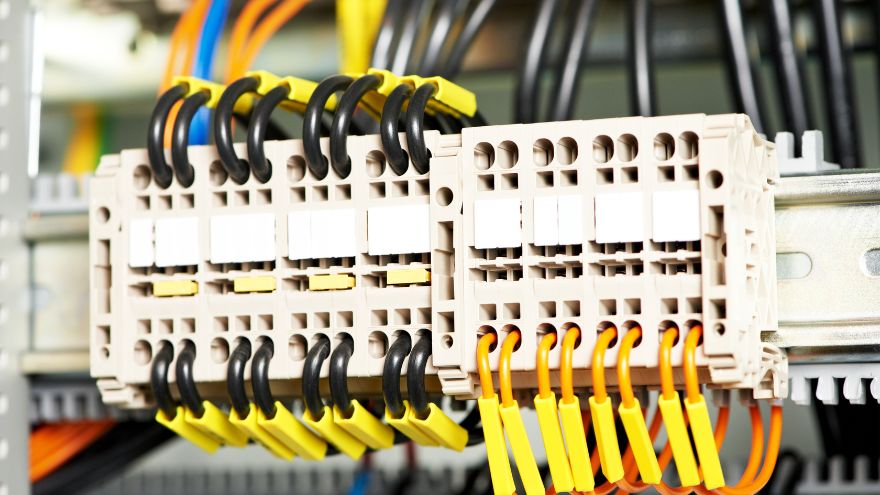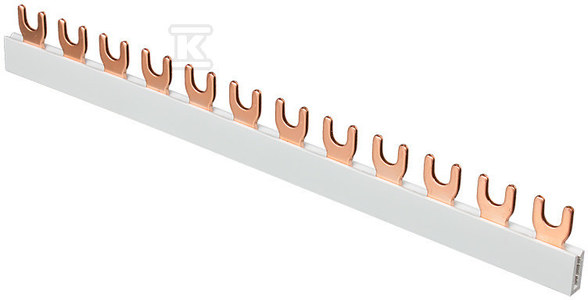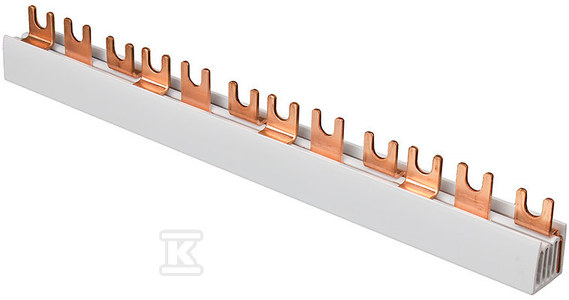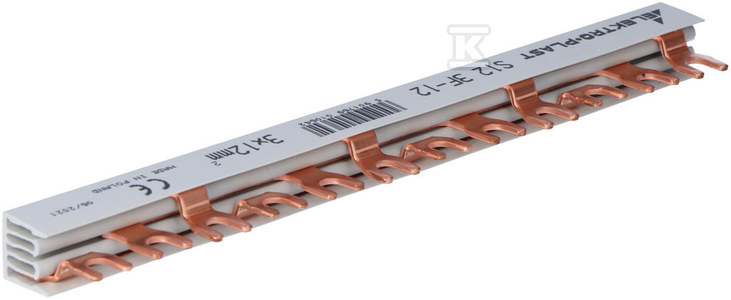Planning an electrical installation requires considering how to supply electricity to individual receivers in your home or company. The product that ensures effective distribution of electricity is a current bus (also known as a busbar). What exactly are busbars used for? When is their use recommended? And which current bus should I choose for the project I am implementing?

Check the current busbars at the Onninen wholesaler
What is the current bus used for?
The current bus is one of the most important electrical installation equipment. It is used to distribute electricity in buildings. It plays an important role in distributing and transmitting current to all receivers that require it. The current bus is mounted in the switchgear for proper arrangement and quick installation of modular devices and power cables.
Connection bus application:
-
 speeds up the construction of the switchgear - you do not waste time on manually creating numerous wire connections, cutting sections and other similar works;
speeds up the construction of the switchgear - you do not waste time on manually creating numerous wire connections, cutting sections and other similar works; - improves the aesthetics and durability of the switchgear - you avoid tangled wires;
- facilitates the course of any repair work - you can easily find the place of damage and remove individual modular devices from the row (you do not have to unscrew the entire rail);
- ensures installation flexibility - you can easily expand or rebuild the switchgear in the future;
- increases protection against electric shock - excludes the risk of touching dangerous parts with a finger (with a minimum protection level of IP20);
- provides protection against short circuits - short circuits are often the result of human error, especially incorrect connections.
In what places will a power rail be useful?
Current rails are used in various industries, places and electrical installations. They are useful both in residential buildings, as well as in industrial, commercial and public facilities. This is one of the most frequently used elements in modern electrical switchboards, especially large ones. The bus ensures effective, safe and orderly distribution of current between modules and provides a number of additional benefits that we described in the previous paragraph.
What are the types of busbar?
The busbars most often found in switchboards have the shape of a strip with switching contacts located on one side. Their structure resembles a comb. The shortest connection rails have only 4 modules, and the longest ones, which you cut yourself, have even 50 or more. Current rails come in many variants. Due to the structure of contacts and application, we distinguish three basic types of busbars.
- Comb busbars – used to make horizontal and vertical connections between circuit breakers and residual current circuit breakers. There are models with various configurations and sizes to choose from.
- Fork busbars - characterized by contacts made of copper with a specific fork shape. They are used for spade connections to the circuit. They often have an additional protective insulating coating, so they can be safely used in home and industrial electrical installations. You can choose from short and long, 1-, 2- and 3-phase models.
- Stick rails – also known as pin rails, with contacts resembling sticks or longitudinal rods. Due to their considerable length and large number of modules, they are used in more complex installations, including: in industry, construction and metallurgy You can choose from vertical pin rails and horizontal rails, single-row and multi-row.
Check the current busbars at the Onninen wholesaler
What should you remember when installing the busbar?
 Selecting the appropriate busbar, then cutting it to the appropriate length and installing it correctly is the basis for safe and effective long-term operation of the electrical installation. Installation errors may result in excessive heating, unstable mounting to the switches, and in extreme cases, lead to a phase-to-phase short circuit. Therefore, it is necessary to strictly follow the installation recommendations for busbars provided by the manufacturers.
Selecting the appropriate busbar, then cutting it to the appropriate length and installing it correctly is the basis for safe and effective long-term operation of the electrical installation. Installation errors may result in excessive heating, unstable mounting to the switches, and in extreme cases, lead to a phase-to-phase short circuit. Therefore, it is necessary to strictly follow the installation recommendations for busbars provided by the manufacturers.
These guidelines include, among others: information about connection points. The work should begin by turning off all electrical devices and preparing the equipment that you intend to connect to the busbar. After completing the assembly activities, be sure to check the correctness of the connections and carry out tests. Verify voltage and current values. Make sure all devices are working properly. If you have any doubts or lack of experience, contact a licensed electrician.
How to choose the right current bus?
The type of bus contacts is not the only parameter that you should pay attention to when choosing the optimal solution for your current/planned electrical installation. Parameters and features such as:
- number of phases in the operated circuit,
- cross-section and length of the rail,
- rail system,
- number of devices to be connected to the bus,
- value of rated continuous current (In),
- maximum rated operating voltage Ue,
- number of rows,
- number of modules,
- compliance with international standards,
- flammability class,
- insulation and its strength (Ui),
- tightness class (IP),
- materials used.
The selection of a current bus depends on the specific requirements of the project and the system used in the switchboard, so it is worth consulting the purchase with a qualified electrician or installer. We encourage you to use the technical support of Onninen specialists. We will help you find the right type of busbar with the right parameters: length, diameter, number of phases, rows, modules, etc. We will indicate which bus model will be best for a specific rated current and for connecting a specific number of circuit breakers. You will be sure that the selected busbar is compatible with your modular equipment.
Current rails at the Onninen wholesaler
At the Onninen electrical wholesaler , you will find a wide range of current busbars tailored to every electrical installation, both in single-family houses and in large-scale industrial facilities. Our range includes comb, spade and pin busbars in various configurations, designed to connect up to 57 devices. All products are made of high-quality materials. They guarantee excellent electrical conductivity and meet strict European standards.
 They are highly resistant to difficult environmental conditions and external factors, which translates into extended service life and, therefore, long-term reliability of your electrical installation. We cooperate only with renowned manufacturers and suppliers of modular equipment. Our partner is, among others: ELEKTRO-PLAST Opatówek - a leading Polish manufacturer of electrical installation equipment with experience dating back to 1980. You can order all current rails online. Many models are available immediately.
They are highly resistant to difficult environmental conditions and external factors, which translates into extended service life and, therefore, long-term reliability of your electrical installation. We cooperate only with renowned manufacturers and suppliers of modular equipment. Our partner is, among others: ELEKTRO-PLAST Opatówek - a leading Polish manufacturer of electrical installation equipment with experience dating back to 1980. You can order all current rails online. Many models are available immediately.
Not sure which busbar meets the requirements of your project? Do you need to match the connectors or cable to the rail? Take advantage of our experience! Write, call or visit one of several dozen Onninen stationary branches throughout Poland. We also encourage you to discover the rest of our electrical equipment range. In our warehouse you will find everything you need for the effective distribution of electricity - at home and in the company. Are you an electrician or fitter? Ask about the offer dedicated to professionals.